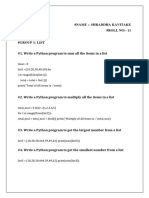0 ratings0% found this document useful (0 votes)
6 viewsHands-On - Python - Collections
The document contains a Python function that processes a given text to count word occurrences, updates a dictionary by deducting specified values, and organizes keys and values into a new dictionary. It also separates a list of numbers into even and odd categories. The function prints the results of these operations.
Uploaded by
arif895178Copyright
© © All Rights Reserved
We take content rights seriously. If you suspect this is your content, claim it here.
Available Formats
Download as TXT, PDF, TXT or read online on Scribd
0 ratings0% found this document useful (0 votes)
6 viewsHands-On - Python - Collections
The document contains a Python function that processes a given text to count word occurrences, updates a dictionary by deducting specified values, and organizes keys and values into a new dictionary. It also separates a list of numbers into even and odd categories. The function prints the results of these operations.
Uploaded by
arif895178Copyright
© © All Rights Reserved
We take content rights seriously. If you suspect this is your content, claim it here.
Available Formats
Download as TXT, PDF, TXT or read online on Scribd
You are on page 1/ 1
import collections
def collectionfunc(text1, dictionary1, key1, val1, deduct, list1):
# Write your code here
dic=dict()
sdic=dict()
t=text1.split()
for w in t:
count=t.count(w)
dic[w]=count
od=collections.OrderedDict(sorted(dic.items()))
for k, v in od.items():
sdic[k]=v
print(sdic)
for k, v in deduct.items():
dictionary1[k]=dictionary1.get(k,0)-v
print(dictionary1)
odic=dict()
for i in range(len(key1)):
odic[key1[i]]=val1[i]
del odic[key1[1]]
odic[key1[1]]=val1[1]
print(odic)
el=list()
ol=list()
for i in list1:
if i%2==0:
el.append(i)
else:
ol.append(i)
eodic=dict()
if len(ol)!=0:
eodic['odd']=ol
if len(el)!=0:
eodic['even']=el
print(eodic)
You might also like
- Write Pythonic Code To Check If A 2. Input Five Integers (+ve and Ve)No ratings yetWrite Pythonic Code To Check If A 2. Input Five Integers (+ve and Ve)4 pages
- 9. comprehensions list and dict question.pdfNo ratings yet9. comprehensions list and dict question.pdf5 pages
- Write a Python Program to Check the Given Number is Prime or NotNo ratings yetWrite a Python Program to Check the Given Number is Prime or Not39 pages
- Computer Science Practical File (Term-2) PDFNo ratings yetComputer Science Practical File (Term-2) PDF18 pages
- Module - 2 ASSIGNMENT: Please Implement by Using PythonNo ratings yetModule - 2 ASSIGNMENT: Please Implement by Using Python4 pages
- Dictionary Question -Practice Questions (1)No ratings yetDictionary Question -Practice Questions (1)6 pages
- Question Paper Python Sem1 Krishna GuptaNo ratings yetQuestion Paper Python Sem1 Krishna Gupta7 pages
- Xii Python Computer Science Practicals English Medium60% (5)Xii Python Computer Science Practicals English Medium2 pages
- file_2023895707_1741228495_Practice Question 7 DNo ratings yetfile_2023895707_1741228495_Practice Question 7 D6 pages
- ITEC-425 / SENG-425: Python Programming Lab Lab 8: Lists and Dictionaries Task 1No ratings yetITEC-425 / SENG-425: Python Programming Lab Lab 8: Lists and Dictionaries Task 13 pages
- Inverse Trigonometric Functions (Trigonometry) Mathematics Question BankFrom EverandInverse Trigonometric Functions (Trigonometry) Mathematics Question BankNo ratings yet



























































